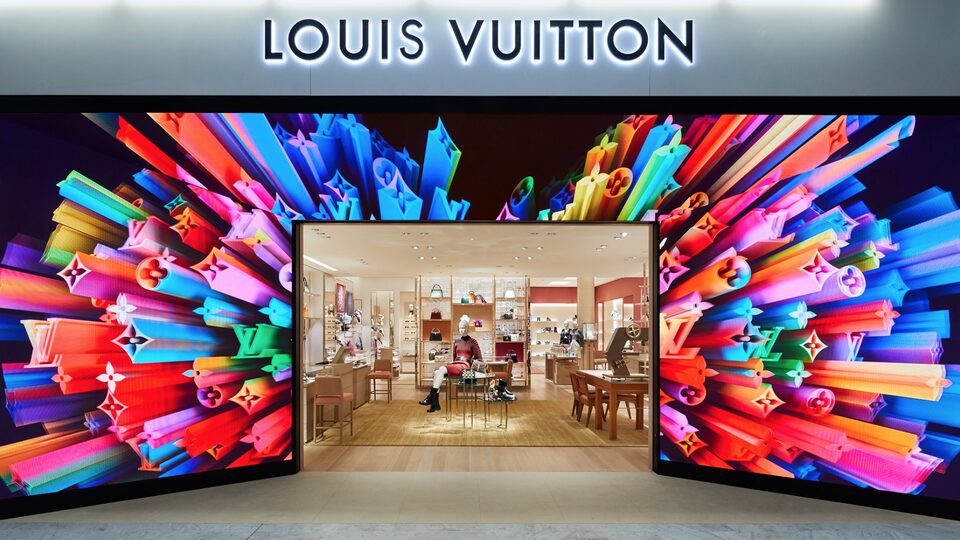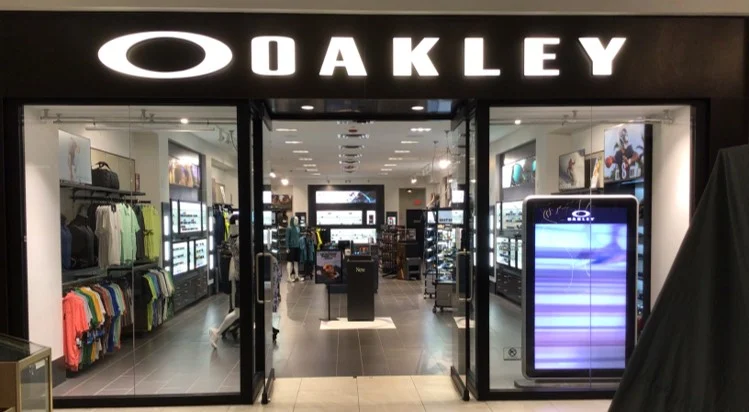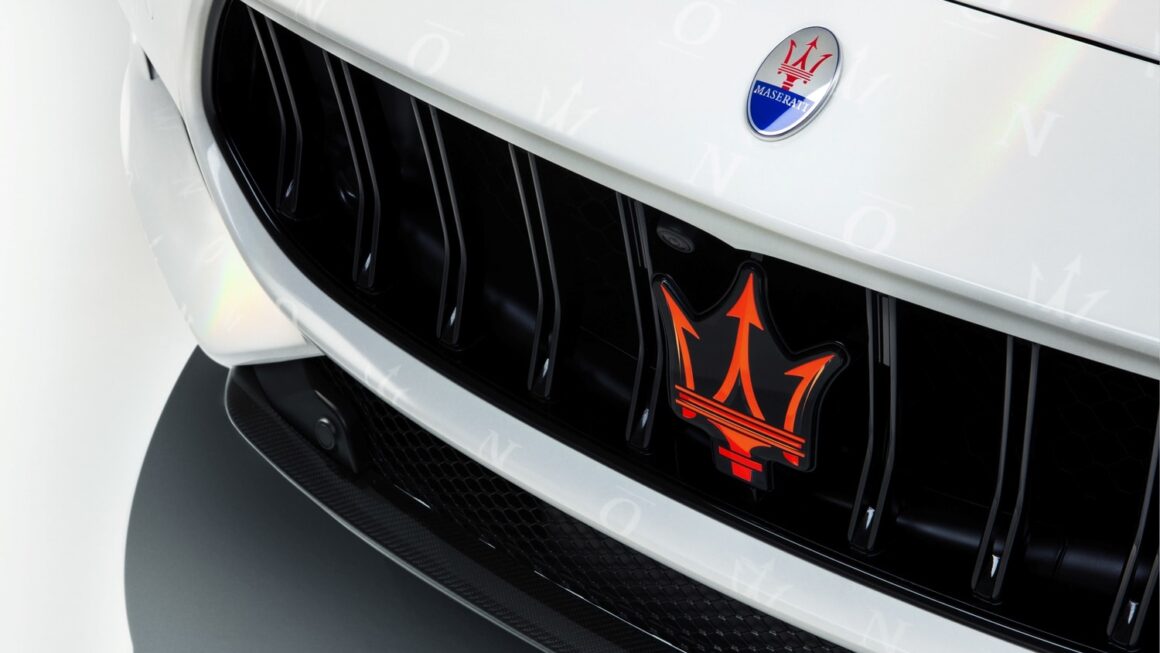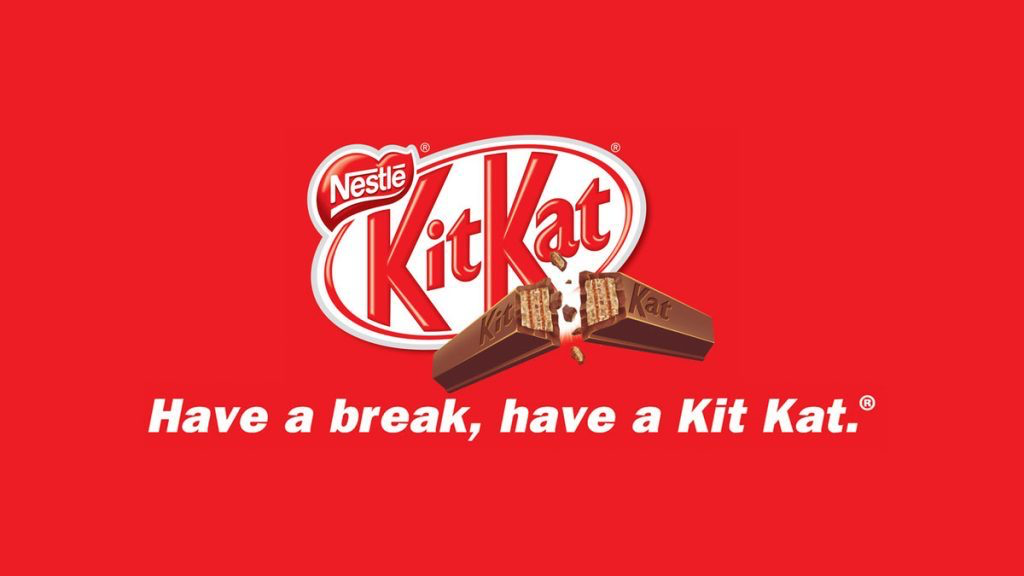LVMH is a French multinational luxury goods conglomerate that was founded in 1987 through the merger of two companies, Moët Hennessy and Louis Vuitton. The company’s name is an acronym for its two original brands, Moët Hennessy and Louis Vuitton.
LVMH’s portfolio of brands includes over 70 prestigious names in fashion, leather goods, perfumes, cosmetics, watches, and jewelry. Some of its well-known brands include Louis Vuitton, Christian Dior, Fendi, Givenchy, Celine, Kenzo, Marc Jacobs, Bulgari, TAG Heuer, and Sephora.
The company is headquartered in Paris, France and has operations in over 70 countries worldwide. It has a workforce of over 160,000 employees and reported €79.2 billion in 2022 and profit from recurring operations of €21.1 billion, both up 23%.
LVMH’s business model is based on the development and acquisition of high-end luxury brands that offer exceptional craftsmanship, quality, and exclusivity. The company’s brands are typically positioned in the highest price points in their respective categories and target affluent consumers who are willing to pay a premium for luxury goods.
LVMH has also been a leader in sustainability initiatives, including implementing responsible sourcing practices, reducing waste, and investing in renewable energy. In 2021, the company announced a new set of ambitious sustainability targets, including reducing its carbon emissions by 50% by 2026 and achieving net-zero emissions by 2050.
Overall, LVMH is one of the largest and most successful luxury goods conglomerates in the world, with a strong brand portfolio, a commitment to sustainability, and a reputation for exceptional quality and craftsmanship.
Founding History of LVMH
The history of LVMH can be traced back to the mid-19th century, with the founding of two companies that would eventually merge to form the conglomerate. Here is a detailed overview of the company’s history:
Moët Hennessy
Moët Hennessy’s history dates back to 1743, when Claude Moët established his own wine trading business in Epernay, France. In 1794, Moët’s grandson, Jean-Rémy Moët, became the owner of the company and expanded its operations, becoming a major exporter of Champagne to European courts.
Meanwhile, in 1765, Irishman Richard Hennessy founded a distillery in Cognac, France, that would eventually become one of the most famous names in the cognac industry. The company was passed down through the Hennessy family and continued to grow in size and reputation throughout the 19th century.
In 1971, the two companies merged to form Moët Hennessy. The new company became the world’s leading producer of champagne and cognac, with brands such as Moët & Chandon, Veuve Clicquot, Hennessy, and Dom Perignon under its umbrella.
Louis Vuitton
In 1854, a young Frenchman named Louis Vuitton opened a workshop in Paris to make high-quality trunks and travel cases. Vuitton’s innovative designs, which included flat tops and reinforced corners to make the cases stackable and durable, quickly gained popularity among the wealthy elite who traveled extensively.
By the end of the 19th century, Vuitton had become a major player in the luxury goods industry, with a reputation for quality and exclusivity. The company continued to expand its product offerings, adding leather goods, handbags, and other accessories to its lineup.
LVMH
In 1987, Moët Hennessy and Louis Vuitton merged to form LVMH, with Bernard Arnault at the helm as chairman and CEO. The merger was a significant moment in the history of the luxury goods industry, as it created the largest conglomerate of luxury brands in the world.
In the early years of the merger between Moët Hennessy and Louis Vuitton, the new company struggled to integrate the two different businesses. However, under the leadership of Bernard Arnault, LVMH began to focus on acquiring additional luxury brands to expand its portfolio and create synergies between the different businesses.
One of LVMH’s most notable acquisitions came in 1999, when the company acquired a controlling stake in the fashion house Christian Dior. This move gave LVMH control over one of the most prestigious names in the fashion industry and allowed the company to expand its presence in the high-end fashion market.
In the early 2000s, LVMH continued to expand its portfolio with the acquisitions of Fendi, Givenchy, and Celine. The company also acquired a number of smaller luxury brands, such as Marc Jacobs, Kenzo, and Loewe.
In addition to its acquisitions, LVMH also invested heavily in its existing brands. The company’s flagship brand, Louis Vuitton, underwent a major transformation in the early 2000s, with the hiring of designer Marc Jacobs and the launch of new product lines such as ready-to-wear clothing and jewelry.
LVMH also expanded its presence in the watch and jewelry market, acquiring Swiss watchmaker TAG Heuer and Italian jewelry brand Bulgari in the early 2010s.
In recent years, LVMH has continued to expand its portfolio with the acquisition of additional luxury brands. In 2018, the company acquired the hotel and resort operator Belmond, and in 2020, it acquired the U.S. jeweler Tiffany & Co. for a record-breaking $16.2 billion.
Despite the challenges posed by the COVID-19 pandemic, LVMH has remained a major player in the luxury goods market, with strong sales growth in the second half of 2020. The company has also continued to prioritize sustainability, announcing in 2021 that it plans to reduce its carbon emissions by 50% by 2026 and achieve net-zero emissions by 2050.
LVMH Brands List
LVMH is a conglomerate of over 70 brands spanning a wide range of industries, including fashion, cosmetics, jewelry, wines and spirits, and hospitality. Some of the most notable brands under the LVMH umbrella include:
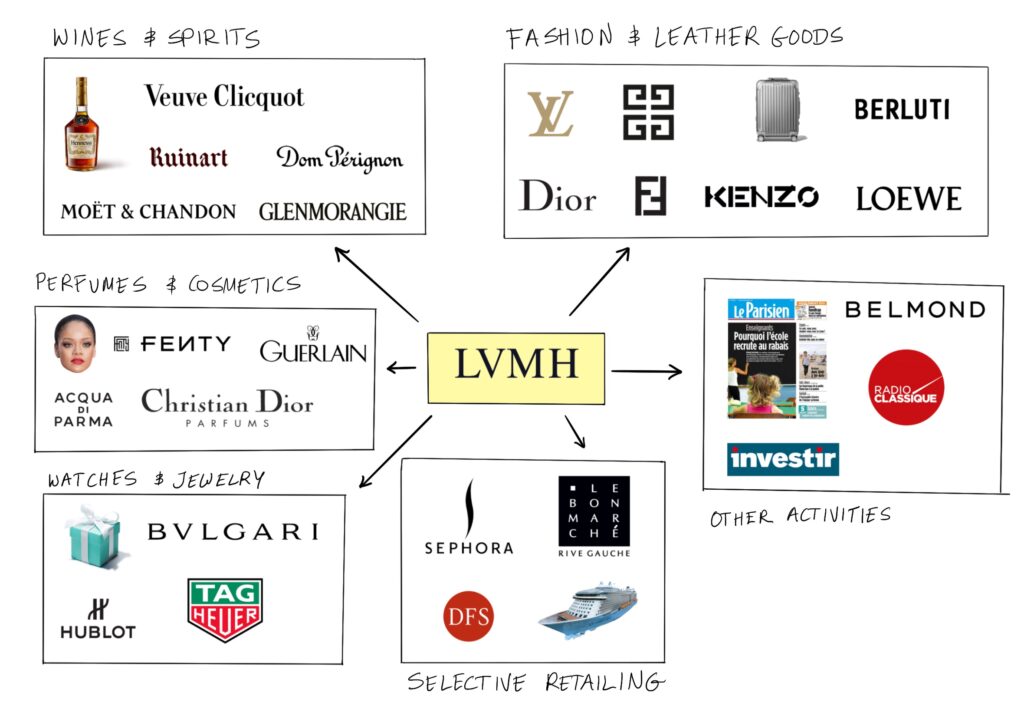
Louis Vuitton – Louis Vuitton is one of the world’s most iconic luxury brands, known for its high-end leather goods, including handbags, luggage, and accessories. The brand also offers clothing, footwear, and jewelry, and has expanded into the hospitality industry with the opening of the Louis Vuitton Maison and other flagship stores.
Moët & Chandon – Moët & Chandon is one of the world’s largest champagne producers and has been a staple of celebrations and special occasions for centuries. The brand is known for its premium range of champagnes, including the famous Dom Pérignon.
Christian Dior – Christian Dior is a French luxury fashion house known for its elegant and feminine designs. The brand offers a wide range of products, including clothing, accessories, fragrances, and makeup, and is highly regarded in the fashion industry for its haute couture collections.
Fendi – Fendi is an Italian luxury fashion brand known for its iconic “FF” logo and high-quality leather goods. The brand offers a range of products, including clothing, handbags, shoes, and accessories, and is known for its collaborations with artists and designers.
Givenchy – Givenchy is a French luxury fashion brand known for its sophisticated and timeless designs. The brand offers a range of products, including clothing, accessories, fragrances, and makeup, and has dressed some of the world’s most famous celebrities and public figures.
Bulgari – Bulgari is an Italian luxury brand known for its high-end jewelry, watches, and accessories. The brand also offers fragrances, skincare products, and other luxury items, and has a reputation for innovation and creativity in its designs.
Sephora – Sephora is a French cosmetics retailer known for its wide range of beauty products from both established and emerging brands. The brand operates over 2,600 stores worldwide and is a leader in the beauty industry, offering customers a personalized shopping experience both in-store and online.
These are just a few of the notable brands under the LVMH umbrella, but the company also owns many other luxury brands, such as Celine, Kenzo, Marc Jacobs, Rimowa, and Veuve Clicquot, among others.
Marketing Strategies of LVMH
LVMH has a reputation for being a master of marketing in the luxury goods industry. The company’s marketing strategies are built on a few key principles, including exclusivity, innovation, and storytelling. Here are some of the marketing strategies that LVMH has employed to build its brand and maintain its position as a leader in the luxury goods industry –
1. Brand Portfolio Strategy
Forget cookie-cutter brands, LVMH thrives on diversity. Their secret weapon? A multi-brand strategy that lets them play in multiple arenas, even with similar or competing products housed under different labels. Need a timeless bag? Louis Vuitton has you covered. Craving bold fashion statements? Fendi’s your go-to. This product diversification across fashion, watches, wine, and more, ensures an expansive reach without brand cannibalization.
But it’s not just about throwing logos in a hat. LVMH is a master of individualized positioning. Each brand shines with its own unique identity and messaging. Louis Vuitton embodies global luxury with a focus on heritage, while Fendi champions innovation and pushes design boundaries. This chameleon-like approach ensures each brand carves its own niche in the luxury landscape.
And the magic doesn’t stop there. LVMH’s diverse portfolio of over 70 brands caters to a vast array of desires. Selective acquisitions and strategic retail expansion further broaden their reach, ensuring there’s a piece of the LVMH pie for everyone. This buffet of luxury fueled by constant innovation and a commitment to core values of exclusivity and excellence, is the recipe for LVMH’s enduring success.
2. Premium Positioning
In the world of LVMH, luxury isn’t just a product, it’s a carefully crafted experience. Forget mass-produced trends – their brands, like Louis Vuitton, stand tall on a pedestal of exclusivity, aspiration, and high-end quality. Think rich heritage dripping from every stitch, meticulous craftsmanship evident in every detail, and innovation that pushes the boundaries of luxury itself.
But this magic doesn’t happen by accident. Premium pricing sets the stage. A Louis Vuitton isn’t just a bag, it’s a symbol of belonging to a select club. Every dollar spent whispers an unspoken promise of exclusivity, making ownership a badge of honor for the high-income individuals and fashion-forward customers who form their target audience.
And the experience extends far beyond the price tag. Branding becomes an art form, meticulously showcasing the brand’s heritage through luxurious events, strategic partnerships, and a focus on storytelling. Imagine hobnobbing with the upper echelon at a Louis Vuitton-sponsored gala, feeling the weight of history and prestige with every sip of champagne.
3. Celebrity and Influencer Endorsements
While LVMH’s brands command luxury real estate all on their own, a dash of stardust never hurts. Their celebrity endorsement strategy is a masterclass in synergy, carefully pairing high-wattage names with the exquisite craftsmanship and heritage of their houses. Imagine Rihanna rocking Fendi or Jaden Smith redefining Louis Vuitton, and you get the picture.
But it’s not just about big names and bright lights. LVMH takes a nuanced approach, tapping into the power of diverse ambassadors like TikTok queen Charli D’Amelio and Hollywood legends like Julia Roberts. This ensures their message resonates across generations and demographics, capturing the hearts and wallets of both seasoned luxury connoisseurs and younger consumers.
This strategic sprinkling of celebrity magic serves a dual purpose. It amplifies brand awareness, letting the world know that LVMH’s brands are where the coolest kids (and adults) hang out. But more importantly, it injects an extra layer of credibility and desirability. When Beyoncé graces a Givenchy gown or Jay-Z rocks a Tag Heuer, it whispers a subliminal message – owning these products elevates you to their level of elite taste and effortless swagger.
4. Flagship Stores and Retail Experience
LVMH’s flagship stores are a portal to another world. Imagine high-end havens nestled in the heart of global metropolises, each meticulously chosen to whisper exclusivity from their cobblestone streets. It’s not just about selling products; it’s about curating experiences that elevate reality and leave you breathless.
Take Guerlain, for example. Their stores are artistic masterpieces, transformed by visionary artists and artisans into unique showcases for their olfactory magic. Every detail, from shimmering mosaics to handcrafted perfume displays, tells a story of heritage and refinement, inviting you to linger, explore, and connect with the true essence of the brand.
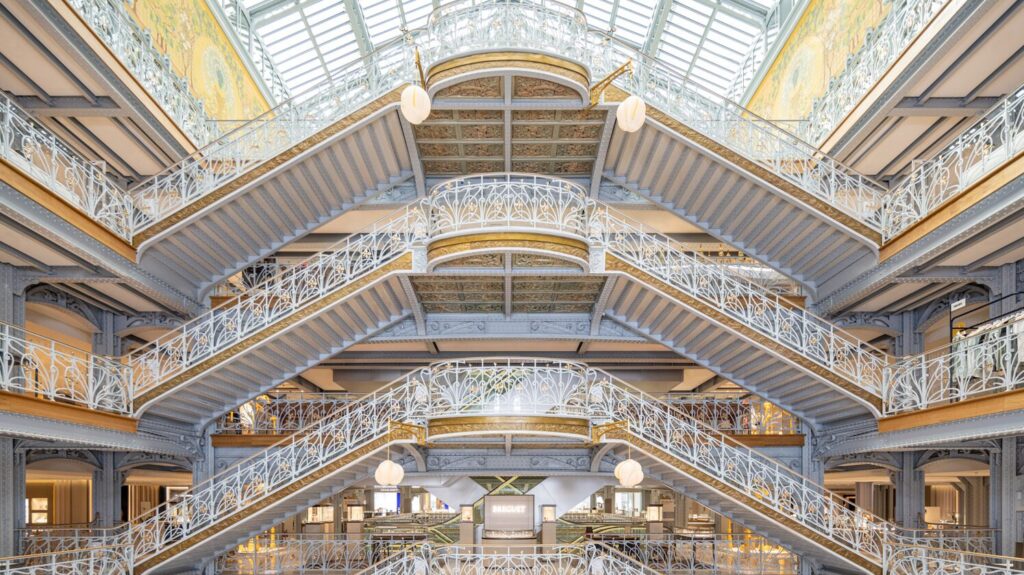
But these spaces aren’t just museums – they’re pulsating hubs of innovation. Louis Vuitton’s flagship stores become cathedrals for their latest creations. Think unveiling new watch lines with dramatic fanfare, immersing you in the brand’s latest narrative and making each purchase feel like a privilege. It’s about more than just owning a product; it’s about becoming part of the LVMH story, a coveted member of their exclusive club.
5. Digital Presence and E-Commerce
The world of luxury isn’t immune to the digital revolution, and LVMH, the undisputed emperor, is leading the charge. Forget dusty shelves and hushed whispers – their digital strategy is a vibrant story woven with multi-brand platforms, strategic partnerships, and immersive experiences.
Imagine a virtual Le Bon Marche, brimming with the finest products from Louis Vuitton to Fendi. That’s 24 Sèvres, LVMH’s multi-brand e-commerce playground, offering exclusive access and personalized service with just a click. But they’re not stopping there. Acquisitions like Lyst and expansion on platforms like TMall show their commitment to conquering every digital corner of the globe.
And LVMH isn’t afraid to push boundaries. LVMH Retail Lab is their playground for testing cutting-edge retail concepts, while the $154 million beauty e-commerce hub in Shanghai signals their dedication to the booming online beauty market. Even partnering with Epic Games for immersive experiences in Fortnite proves they’re always one step ahead, blurring the lines between reality and virtual luxury.
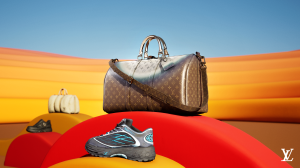
But the secret sauce lies in their decentralized approach. Each brand, from Dior to Sephora, dances to its own digital tune, crafting customized strategies that resonate with their unique audiences. This agility keeps them fresh and responsive, ensuring they stay ahead of the ever-evolving digital landscape.
6. Heritage and Craftsmanship Storytelling
In the kingdom of luxury, LVMH doesn’t just reign – they weave tales of time and passion. Forget generic labels – each of their 75 brands boasts a unique story, a story woven from heritage, craftsmanship, and resolute modernity. Imagine Louis Vuitton’s trunks whispering tales of far-flung voyages, while Dior’s gowns drape themselves in the elegance of couture legends. It’s not just marketing; it’s the beating heart of every LVMH creation.
But these stories aren’t penned in dusty archives. LVMH’s decentralized structure gives each brand the freedom to spin its own narrative, responding quickly to cultural tides and crafting experiences that resonate with their audience. The spirit of creativity and innovation, one of LVMH’s core values, shines through, ensuring these stories stay fresh and captivating.
This focus on heritage isn’t merely nostalgic. It’s about preserving precious techniques, the savoir-faire that elevates every LVMH product to a work of art. Imagine meticulous stitching passed down through generations, the delicate touch of an artisan breathing life into leather and silk. This respect for the past fuels constant innovation, ensuring each collection pushes the boundaries of what luxury can be.
7. Limited Editions and Exclusivity
Scarcity breeds desire. This simple principle lies at the heart of LVMH’s masterful use of limited editions and collaborations to fuel excitement around its diverse empire of luxury brands. From exquisite champagnes to iconic handbags, LVMH crafts experiences that go beyond mere products, offering a taste of the exclusive.
Limited Editions as Events: Take the LVMH Vins d’Exception Limited Edition 2016. This ultra-rare collection of vintage wines wasn’t just a purchase; it was an invitation to a private club, a chance to own a piece of history. Similarly, the Patou x Sita Abellan collaboration transformed an everyday accessory into a conversation starter, a badge of belonging for those lucky enough to snag one of the bags before they vanished.
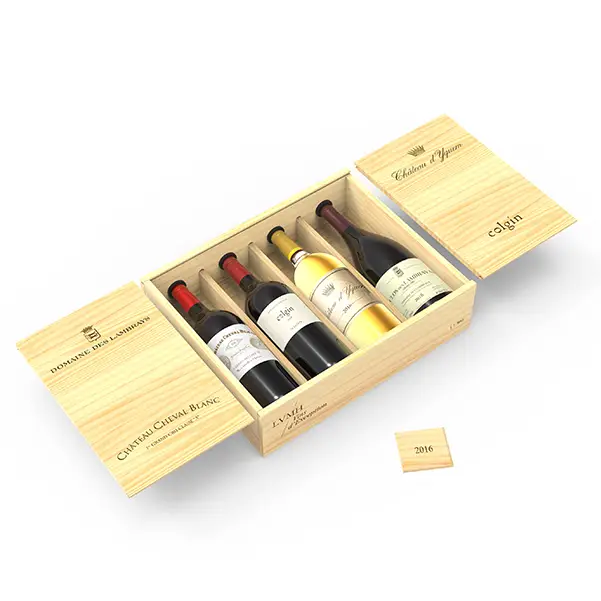
Planned Scarcity, Mastered Art: This isn’t mere randomness. LVMH meticulously orchestrates scarcity, creating a thrill of the chase for discerning consumers. Limited editions like the Louis Vuitton Fashion Eye box set, with its curated collection of artistic visions, become coveted collector’s items, their value enhanced by their finite availability. Even a charitable initiative like the 300-set collectors’ case for restaurant workers leveraged this strategy, turning generosity into a badge of early-adopter cool.
8. Event Sponsorships and Fashion Shows
LVMH knows how to command attention on the world stage. Their event sponsorship strategy is a dazzling masterpiece, illuminating their brands with the brightest lights and placing them at the heart of iconic moments. Take the 2024 Paris Olympics: LVMH isn’t just a sponsor, they’re woven into the very fabric of the Games. Imagine championing French athletes like Leon Marchand, Mélanie de Jesus dos Santos, and Enzo Lefort, their triumphs adding another layer of glory to the LVMH legacy.
But it’s not just about athletic prowess. LVMH elevates the Games with unforgettable aesthetics. Sephora paints the torch relay with a touch of beauty magic, while Louis Vuitton and Dior transform the athletes into paragons of style with custom-designed uniforms. Every glimpse is a reminder – LVMH isn’t just a luxury brand, it’s the epitome of Parisian elegance and global sophistication.
And their commitment to captivating the world doesn’t stop there. LVMH’s fashion shows are more than just runway presentations; they’re cultural happenings, orchestrated with the precision of a grand symphony. Imagine Pharrell Williams setting the stage for the Louis Vuitton Men’s Pre-Fall 2024 Show in Hong Kong, or Nicolas Ghesquière’s breathtaking vision unfolding at the Louis Vuitton Women’s Spring-Summer 2024 Show in Paris. These aren’t just clothes, they’re stories whispered in silk and leather, pushing the boundaries of fashion and leaving the world breathless with anticipation for the next act.
9. Strategic Acquisitions
LVMH’s secret weapon is strategic acquisitions. They haven’t just grown, they’ve strategically gobbled up 37 companies across fashion, watches, jewelry, and even digital platforms. Think Christian Dior, a billion-dollar bite in 1987 that gave them instant fashion cred. Or Bulgari, a 5.2 billion dollar diamond in 2011, securing their jewelry crown.
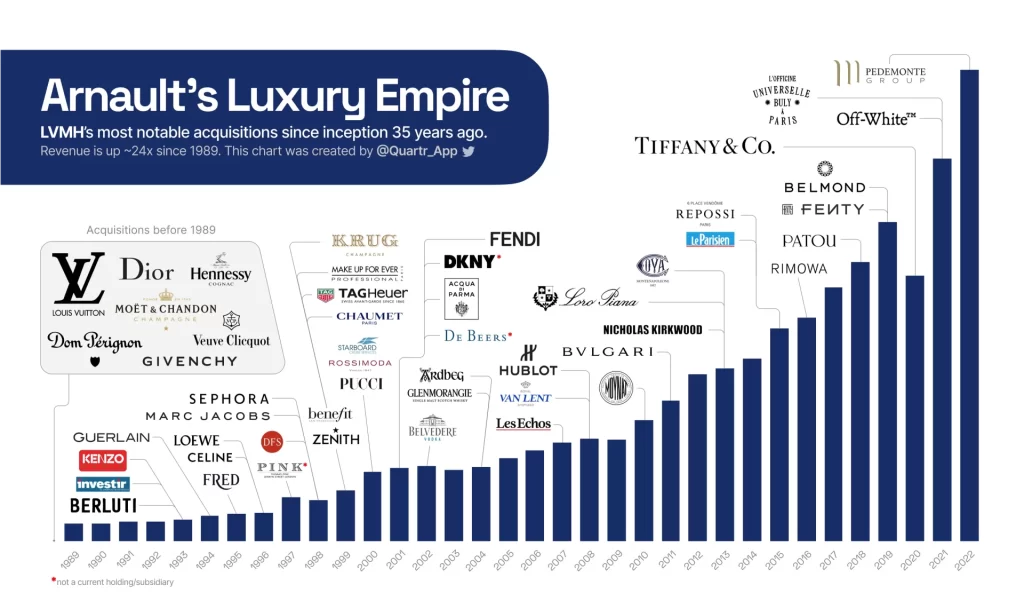
But it’s not just about big names and bigger bucks. LVMH hunts for “sleeping beauties”, brands with hidden potential waiting to be awakened. Take Tiffany & Co., a classic name they saw as a gem in the rough, a way to dominate the booming jewelry market. Every acquisition is a calculated brushstroke, filling gaps in their portfolio and painting a masterpiece of luxury dominance.
This isn’t just about collecting trophies. Think of each acquisition as a new facet in the LVMH diamond. Hublot and TAG Heuer add sparkle to their watch empire, while ventures into B2C e-commerce and consumer digital future-proof their reach. It’s a game of chess, played with billion-dollar pieces, and LVMH, the undisputed master, keeps checkmating the competition by always adding new, strategic weapons to their arsenal.
Marketing Mix of LVMH
LVMH uses a combination of marketing elements, also known as the marketing mix, to promote its luxury brands and products. The marketing mix consists of four main components: product, price, place, and promotion. Here’s how LVMH utilizes these elements to create a successful marketing mix:
1. Product
LVMH’s focus on quality and innovation is evident in its product offerings. The company invests heavily in research and development to create new products and improve existing ones. For example, in the fragrance category, LVMH’s brands, such as Dior and Givenchy, regularly release new scents that feature innovative ingredients and packaging. In the fashion category, LVMH’s brands, such as Louis Vuitton and Fendi, are known for their high-quality materials, meticulous attention to detail, and unique designs.
2. Price
LVMH’s pricing strategy is designed to maintain the exclusivity of its brands and products. The company sets prices at a premium level, which reinforces the perception of luxury and exclusivity. LVMH’s pricing strategy varies by brand and product line. For example, Louis Vuitton’s leather goods are priced higher than its ready-to-wear collections, while Dior’s haute couture line is priced higher than its ready-to-wear collections.
3. Place
LVMH’s retail locations are carefully selected to maintain the exclusivity of its brands. The company operates flagship stores in high-end shopping districts and major cities around the world. These stores are designed to create a luxurious and immersive shopping experience, with high-end finishes and personalized service. In addition to company-owned stores, LVMH also sells its products through department stores, specialty boutiques, and e-commerce channels.
4. Promotion
LVMH’s marketing campaigns are focused on creating an emotional connection with consumers and reinforcing the luxury and exclusivity of its brands. The company uses a variety of promotional tactics to achieve this, including celebrity endorsements, collaborations, and limited-edition products. For example, Louis Vuitton has partnered with artists such as Jeff Koons and Yayoi Kusama to create limited-edition collections that generate buzz and create demand. LVMH also invests in experiential marketing, such as pop-up stores and brand experiences, to create a sense of exclusivity and immersion.
In addition to the four main components of the marketing mix, LVMH also places a strong emphasis on customer service and brand reputation. The company’s sales associates are trained to provide personalized and attentive service to customers, which helps to reinforce the luxury and exclusivity of its brands. LVMH also places a strong emphasis on sustainability and social responsibility, which helps to enhance its brand reputation and appeal to socially-conscious consumers.
STP (Segmentation, Targeting and Positioning) of LVMH
STP stands for segmentation, targeting, and positioning, which are the three key elements of marketing strategy. Here’s how LVMH utilizes the STP framework to effectively promote its luxury brands:
Segmentation: LVMH segments its target market based on demographics, psychographics, and behavior. The company’s brands are designed to appeal to different market segments, ranging from young fashion-conscious consumers to high-net-worth individuals. For example, LVMH’s fashion brands such as Louis Vuitton and Dior target high-end fashion-conscious consumers, while its spirits brands such as Hennessy and Moet & Chandon target individuals who enjoy luxury alcohol products.
Targeting: LVMH targets its marketing efforts towards the identified market segments by tailoring its brand messaging and marketing channels. The company uses a variety of marketing channels such as social media, advertising, public relations, and events to reach its target market. For example, LVMH’s fashion brands advertise in high-end fashion magazines and sponsor fashion events, while its beauty brands such as Sephora and Benefit Cosmetics utilize social media and influencer marketing to reach a younger audience.
Positioning: LVMH positions its brands as luxury and exclusive, with a focus on quality, craftsmanship, and innovation. The company’s brands are positioned as aspirational and iconic, with a rich heritage and a strong association with high-end luxury. LVMH’s positioning strategy varies by brand, with each brand having its unique identity and messaging. For example, Louis Vuitton is positioned as a global luxury brand with a focus on high-quality leather goods, while Fendi is positioned as a luxury fashion brand with a strong focus on innovative designs.
In summary, LVMH utilizes the STP framework to effectively market its diverse range of luxury brands. By segmenting its target market, tailoring its marketing efforts to reach those segments, and positioning its brands as luxury and exclusive, LVMH has been able to create a successful marketing strategy that has helped it maintain its position as a global leader in the luxury industry.
Also Read: Brand | Louis Vuitton- Success Factors Of The Top Luxury Brand
Porter’s Five Forces of LVMH
Porter’s Five Forces is a framework used to analyze the competitive intensity and attractiveness of an industry. Here’s how it applies to LVMH:
Threat of new entrants: The luxury industry has high barriers to entry due to the high costs of production, distribution, and marketing. LVMH, as one of the largest luxury goods conglomerates in the world, has economies of scale that make it difficult for new entrants to compete. Additionally, LVMH’s strong brand portfolio and reputation give it a competitive advantage that is difficult for new entrants to replicate.
Bargaining power of suppliers: LVMH sources materials from a range of suppliers and has long-term contracts with many of them, which reduces the bargaining power of individual suppliers. Additionally, LVMH’s size and purchasing power give it an advantage in negotiating favorable terms with suppliers.
Bargaining power of buyers: The bargaining power of buyers in the luxury industry is low due to the exclusivity and high prices of luxury goods. LVMH’s strong brand portfolio and reputation give it an advantage in retaining loyal customers who are willing to pay a premium price for its products.
Threat of substitutes: The threat of substitutes in the luxury industry is relatively low due to the unique and exclusive nature of luxury goods. While there are alternatives to luxury goods, such as fast fashion or affordable luxury brands, they do not offer the same level of exclusivity or prestige as LVMH’s luxury brands.
Rivalry among existing competitors: The luxury industry is highly competitive, with a small number of dominant players, including LVMH, Kering, and Richemont. LVMH’s strong brand portfolio and reputation give it an advantage in this competitive landscape. However, competition from other luxury brands and retailers can still impact LVMH’s market share and profitability.
In summary, Porter’s Five Forces analysis shows that while LVMH faces competition and challenges in the luxury industry, its strong brand portfolio, reputation, and economies of scale give it a competitive advantage that is difficult for new entrants or individual suppliers to replicate.
Also Read: Elevating Luxury: Exploring Marketing Strategies of Louis Vuitton
To read more content like this, subscribe to our newsletter
